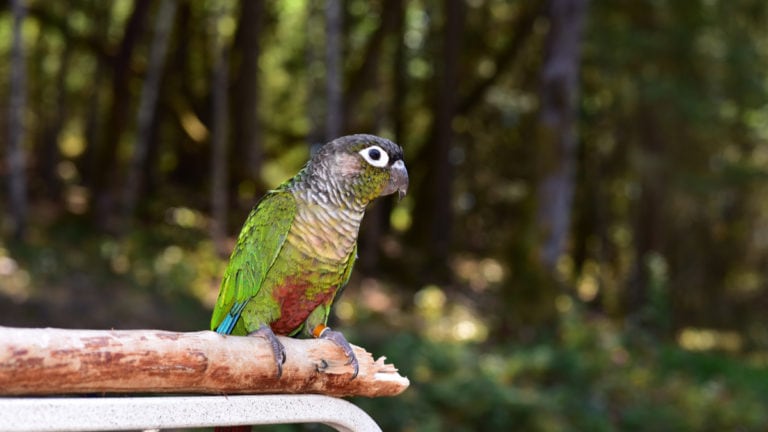It’s a challenge to train an older or re-homed pet bird that has learned, through an unhappy history, to distrust people.
“These birds are just like any pet that’s been traumatized, you don’t know what they’ve been through,” says Byron J.S. de la Navarre, DVM at the Animal House of Chicago. “Gaining their trust is a slow process that requires a lot of patience.”
Fear and stress may cause them to act defensively or aggressively. They may retreat to the back of their cage, puff up their feathers, scream or even try to bite, he says.
But this challenge can also be extremely rewarding. Training can help rebuild the trust of older and re-homed birds so you can establish a healthy, cooperative relationship with your new pet, de la Navarre says. To help you and your bird get started, here are some of his recommended training methods.
Plant the Seed of Trust with Seed
“I’ve tamed a lot of wild-caught Amazon parrots and gained their trust food and a safe environment,” de la Navarre says. “But the food really brought them to me.”
To gain the bird’s trust, find a type of seed they really like. While the bird is inside his cage, try to coax him toward you with a delicious seed. Try a premium blend of seed like ZuPreem Pure Fun Enriching Variety Parrot Food that contains a blend of seeds, pellets, fruit like dried bananas and vegetables like peas. Or try Kaytee Fiesta Variety Mix Parrot Food which contains a blend of sunflower seeds, corn, buckwheat, peanuts, almonds, raisins, papaya and more.
Treats are another way to bring your bird to you. You can experiment with different types and brands to see which ones are the most effective. Try Kaytee Fiesta Blueberry Flavored Yogurt Dipped Sunflower Seeds, a delicious blend of real fruit pieces and sunflower seeds dipped in a creamy yogurt coating. Or try Vitakraft Super Fruit Cocktail Parrot & Cockatiel Treats which combines a delicious blend of peanuts, bananas, pineapple, peas, carrots and more.
Talk softy to the bird and use your hands, or if biting is a concern, forceps to hold the treats and encourage him to come towards you. If the bird doesn’t come right away or exhibits aggressive behavior, take a break, let the bird relax in his cage and try again later, he says. And give yourself a break too. This step can take up to a week or longer depending on the bird’s stress level and how receptive he is. But don’t give up.
“As time progresses, they will come towards you to get the reward and that is a step in the right direction.”
Step Up to the Perch Technique
Eventually, you will want your bird to perch on your hand, but know this isn’t going to happen right way. Once you have developed a positive association with your bird through food, the next step is to encourage him to step on a perch or a stick that you’re holding, de la Navarre says. It will also allow others in the household to safely handle your bird. If you don’t already have a perch, try Polly’s Pet Products Sand Walk Orthopedic Bird Perch.
“The perch is an extension of your hand,” he says. “You want the bird to see the perch is attached to our hand so he may associate your hand with stability and begin to trust you.”
Again, speak softly and offer the stick to your bird just above its feet at its abdomen. Their natural instinct is to step up onto the higher object and you can even tell them to “step up” so they’ll learn that verbal association, he says. Hold your hands steady on either side of the perch so it does not wobble. You can tilt the perch so the bird will move towards the center so he’s better balanced.
If your bird does not step onto the perch, hold a favorite treat just out of reach so he must step up to retrieve it. Each time your bird steps up, reward him with his favorite food or treat.
“They can flutter so you may want to try this technique over the bed or a soft place where they can land versus the hard floor,” de la Navarre says.
If they begin to exhibit stress-related behavior, place them back in their cage, reward them with treats and try again later.
Next Step: Your Hand
Once you and your bird have mastered stepping up and standing on the perch, try coaxing him to stand on your hand. Using the same technique, offer the perch to the bird just above his feet and holding your hands steady on either side of the perch, let your bird step up. Say “step up” so your bird will associate the command to the action. Tilt the perch slightly so the bird moves to the center and gradually move your hand towards the center too. Speaking softly, encourage the bird to step up on your hand. When he does, reward with treats.
If your bird is reluctant, keep trying, de la Navarre says. It may take a few weeks or more, but your bird will learn that your hand is a safe place.
“You can’t expect the bird to trust in a day,” he says. “Try training for five minutes day and if you see he’s getting stressed, stop. Always end on a positive note.”

Chris Brownlow has been writing about pets for over 10 years. As a writer who believes in immersing herself in her topic, she has tasted more than 20 different flavors of dog and cat food while working on an advertising campaign for PetSmart. Prior to her pet days, Chris was a print and digital journalist at The Tampa Tribune and The Virginian-Pilot.
Featured Image: Via MFer Photography/Flickr
Share:














